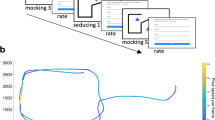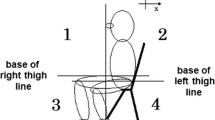Abstract
Impression effects of videotaped dyadic interactions were compared with 3D-computer animations based on movement transcripts of the same interactions to determine whether similar effects could be obtained. One minute sequences of movement behavior taken from three different dyadic interactions were transcribed using the Bernese Coding System (BCS). Descriptive data were converted into animation scripts for professional animation software. Original video documents and computer animations were shown to separate groups of observers and their socio-emotional impressions were assessed on a standard adjective checklist. Only marginal differences were found between the two presentation modes. On the contrary, the data point to remarkable similarities in the impression ratings in both conditions, indicating that most of the relevant social information available to observers in the video recordings was also conveyed by computer animations. Overall, the data suggest that the systematic use of computer animation techniques in nonverbal research deserves further scientific attention.
Similar content being viewed by others
References
Altorfer, A. (1989). Verbale und nichtverbale Verhaltensweisen von Depression als "actives Verhalten" zur Interaktionssteuerung [Depressive patients' verbal and nonverbal behavior as means of actively controlling interaction]. Schweizerische Zeitschrift f ¨ur Psychologie, 48 (2), 99–111.
Altorfer, A. (1988). Eine Methode zur Untersuchung der interaktiven Bedeutung von nichtverbalen Verhaltensweisen [A method for analysing interactional meaning of nonverbal behavior]. Sprache und Kognition, 7 (2) 99–112.
Altorfer, A., Jossen, S., & W¨urmle, O. (1997). Eine Methode zur zeitgenauen Aufnahme und Analyse des Bewegungsverhaltens [A methodological approach to measure and analyze movement behavior]. Zeitschrift f ¨ur Psychologie, 205 (1), 83–117.
Argyle, M. (1972). Non-verbal communication in human social interaction. In R. A. Hinde (Ed.), Nonverbal communication. London: Methuen.
Bente, G. (2000). Digital representation and experimental simulation of nonverbal behavior. In L.P.J.J. Noldus (Ed.), Proceedings of the 3rd International Conference on Methods and Techniques in Behavioral Research (pp. 16–17). Nijmegen: Katholieke Universiteit Nijmegen.
Bente, G. (1989). Facilities for the graphical computer simulation of head and body movements. Behavior Research Methods, Instruments, & Computers, 21 (4), 455–462.
Bente, G., Donaghy, W.F., & Suwelack, D. (1998). Sex Differences in body movement and Visual Attention: An Integrated Analysis of Movement and Gaze in Mixed-Sex Dyads. Journal of Nonverbal Behavior, 22 (1), 31–58.
Bente, G., Feist, A., & Elder, S. (1996). Person perception effects of computer-simulated male and female head movement. Journal of Nonverbal Behavior, 20 (4), 213–228.
Bente, G., Petersen, A., & Kr¨amer, N.C. (1999). Virtuelle Realit¨at und parasoziale Interaktion. Entwicklung eines Verfahrens zur Untersuchung sozio-emotionaler Effekte computersimulierten Verhaltens. [Virtual reality and parasocial interaction. A tool for analyzing socio-emotional effects of computer-simulated behavior]. Research Report, University of Cologne.
Berry, D. S. (1990). The perceiver as naive scientist or the scientist as naive perceiver? An ecological view of social knowledge acquisition. Contemporary Social Psychology, 14 (3), 145–153.
Berry, D. S., Kean, K. J., Misovich, S. D., & Baron, R. M. (1991). Quantized displays of human movement: A methodological alternative to the point-light display. Journal of Nonverbal Behavior, 15 (2), 81–97.
Bers, J. (1996). A body model server for human motion capture and representation. Presence: Teleoperators and virtual environments, 5 (3), 381–392.
Cassell, J., Bickmore, T., Billinghurst, M., Campbell, L., Chang, K, Vilhjáalmsson, H., Yan, H. (1999). Embodiment in conversational interfaces: Rea. CHI'99 Conference Proceedings (pp. 520–527). Association for Computing Machinery.
Cassell, J., Steedman, M., Badler, N. Pelachaud, C., Stone, M. Douville, B., Prevost, S. & Achorn, B. (1994). Modeling the interaction between speech and gesture. In A. Ram & K. Eiselt (eds.), Proceedings on the sixteenth annual conference of the cognitive science (pp. 153–158). LEA.
Cohen, J. (1992). A power primer. Psychological Bulletin, 112 (1), 155–159.
Cohen, J. (1988). Statistical power analysis for the behavioral sciences (Second Edition). Hillsdale, NJ: LEA.
Cutting, J. E. & Proffitt, D. R. (1981). Gait perception as an example of how we perceive events. In R. D. Walk & H. L. Pick (Eds.), Intensory perception and sensory integration (pp. 249–273). New York: Plenum.
Davis, M. (1972). Understanding body movement. An annotated bibliography. New York: Arno Press.
Donaghy, W. C. (1989). Nonverbal communication measurement. In P. Emmert & L. Barker (Eds.), Measurement of communication behavior (pp. 296–332). White Plains, NY: Longman.
Dovidio, J. F., Ellyson, S. L., Keating, C. F., Heltman, K. & Brown, C. E. (1988). The relationship of social power to visual displays of dominance between men and women. Journal of Personality and Social Psychology, 54, 233–242.
Duncan, S. Jr. & Fiske, D.W. (1979). Dynamic patterning in conversation. American Scientist, 67, 90–98.
Duncan, S., Jr., Kanki, B.G., Mokros, H., & Fiske, D.W. (1984). Pseudounilaterality, simplerate variables, and other ills to which interaction research is heir. Journal of Personality and Social Psychology, 46 (6), 1335–1348.
Ekman, P. & Friesen, W. V. (1978). The facial action coding system. Palo Alto, CA: Consulting Psychology Press.
Ekman, P. & Friesen, W. V. (1969). The repertoire of nonverbal behavior: Categories, origins, usage, and coding. Semiotica, 1, 49–98.
Ellsworth, P. C. & Ludwig, L. M. (1972). Visual behavior in social interaction. Journal of Communication, 22, 375–403.
Essa, I. A., (1995). Analysis, interpretation and synthesis of facial expressions. PHD-Thesis, MIT.
Essa, I. A. & Pentland, A. (1995). Facial expression recognition using visually extracted facial action parameters. In M. Bichsel (Ed.), International workshop on automatic face-and gesture-recognition (pp. 34–40). Züurich: MultiMedia Laboratory.
Faul, F. & Erdfelder, E (1992). GPower: A priori, post-hoc, and compromise power analyses for MS-DOS [Computer program]. Bonn, FRG: Bonn University, Department of Psychology.
Fleiss, J. L. (1981). Statistical Methods for Rates and Proportions (Second Edition). New York: John Wiley & Sons.
Frey, S., Hirsbrunner, H. P., Florin, A., Daw, W., & Crawford, R. (1983). A unified approach to the investigation of nonverbal and verbal behavior in communication research. In Doise, W. & Moscovici, S. (Eds.), Current issues in European social psychology (pp. 143–199). Cambridge: Cambridge University Press.
Grammer, K., Filova, V. & Fieder, M. (1997). The communication paradox and a possible solution: Toward a radical empiricism. In A. Schmitt, K. Atzwanger, K. Grammer & K. Sch¨afer (Eds.), New aspects of human ethology (pp. 91–120). New York: Plenum.
Grammer, K. Kruck, K. B., & Magnusson, M. S. (1998). The courtship dance: Patterns of nonverbal synchronization in opposite-sex encounters. Journal of Nonverbal Behavior, 22 (1), 2–29.
Hall, E. T. (1959). The silent language. Garden City: Doubleday.
Harmon, L. D. (1973). The recognition of faces. Scientific American, 229, 71–82.
Hirsbrunner, H. P., Frey, S. & Crawford, R. (1987). Movement in human interaction. Parameter formation and analysis. In A. W. Siegmann & S. Feldstein (Eds.), Nonverbal behavior and communication (pp. 99–140). Hillsdale, NJ: LEA.
Hofst¨atter, P.R. (1959). Zur Problematik der Profilmethode. Diagnostica, 5, 19–24.
Johansson, G. (1973). Visual perception of biological motion and a model for its analysis. Perception & Psychophysics, 14, 201–211.
Johansson, G. (1976). Spatio-temporal differentiation and integration in visual motion perception. Psychological Research, 38, 379–393.
Kempter, G. (in press). Trait attribution to reanimated gestural movements. Behavior Research Methods, Instruments, and Computers.
Krohne, H. W., Egloff, B., Kohlmann C. W. & Tausch, A. (1996). Untersuchungen mit einer deutschen Version der "Positive and Negative Affect Schedule" (PANAS) [Evaluation of the german version of the 'Positive and Negative Affect Schedule' (PANAS)]. Diagnostica, 42 (2), 139–156.
Landis, J. & Koch, G. G. (1977). The measurement of observer agreement for categorical data. Biometrics, 33, 159–174.
Leuschner, H. (1999). Vom Videotranskript zur Computeranimation nonverbalen Verhaltens: Methodendokumentation. [From video-transcript to computer animation of nonverbal behavior. Method documentation]. Research Report, University of Cologne.
Lewis, R. J., Derlega, V. J., Shankar, A., Cochard, E., & Finkel, L. (1997). Nonverbal correlates of confederates' touch: Confounds in touch research. Journal of Social Behavior and Personality, 12 (3), 821–830.
Mehrabian, A. (1969). Significance of posture and position in the communication of attitude and status relationships. Psychological Bulletin, 71 (5), 359–372.
Mehrabian, A. (1970). A semantic space for nonverbal behavior. Journal of Consulting and Clinical Psychology, 35 (2), 248–257.
Morrone, M. C., Burr, D. C., & Ross, J. (1983). Added noise restores recognizability of coarse quantized images. Nature, 305, 226–228.
Schouwstra, S. J. & Hoogstraten, J. (1995). Head position and spinal position as determinants of perceived emotional state. Perceptual and Motor Skills, 81 (2), 673–674.
Thá orisson, K. R. (1996). Communicative humanoids. A computational model of psychosocial dialogue skills. PHD-Thesis, MIT.
Trautner, H. M. (1991). Children's and adults awareness of sex-stereotyped postures. Paper presented at the Eleventh Biennal Meeting of the ISSBD, Minneapolis.
Watson, D., Clark, L. A. & Tellegen, A. (1988). Development and validation of brief measures of positive and negative affect: The PANAS scales. Journal of Personality and Social Psychology, 54, 1063–1070.
Author information
Authors and Affiliations
Corresponding author
Rights and permissions
About this article
Cite this article
Bente, G., Krämer, N.C., Petersen, A. et al. Computer Animated Movement and Person Perception: Methodological Advances in Nonverbal Behavior Research. Journal of Nonverbal Behavior 25, 151–166 (2001). https://doi.org/10.1023/A:1010690525717
Issue Date:
DOI: https://doi.org/10.1023/A:1010690525717




